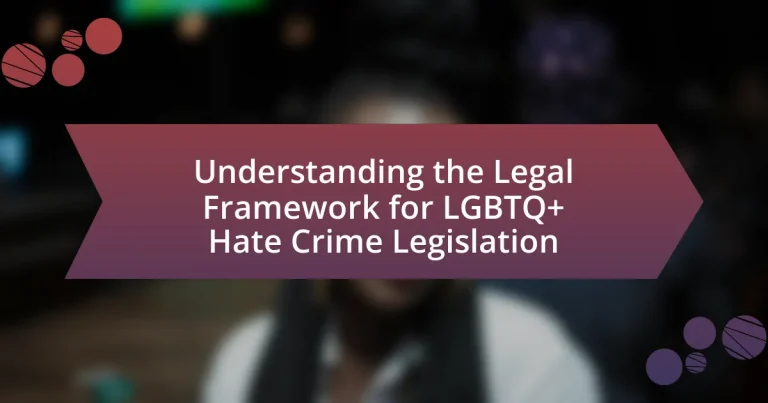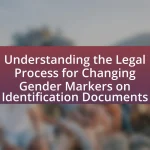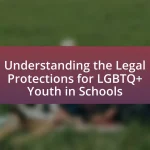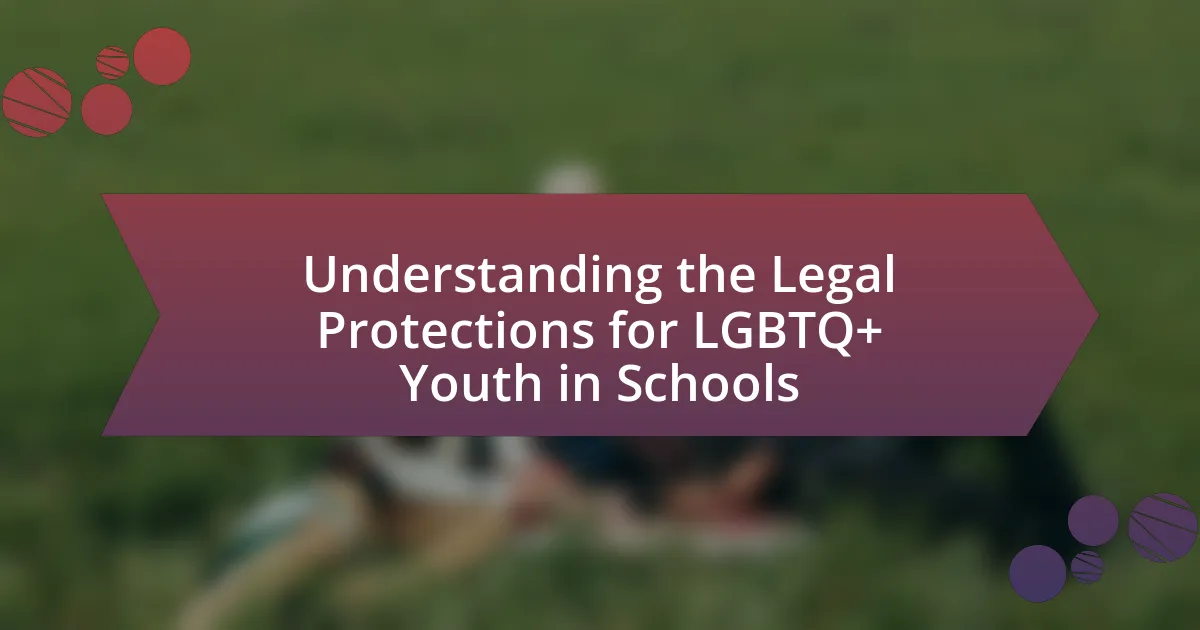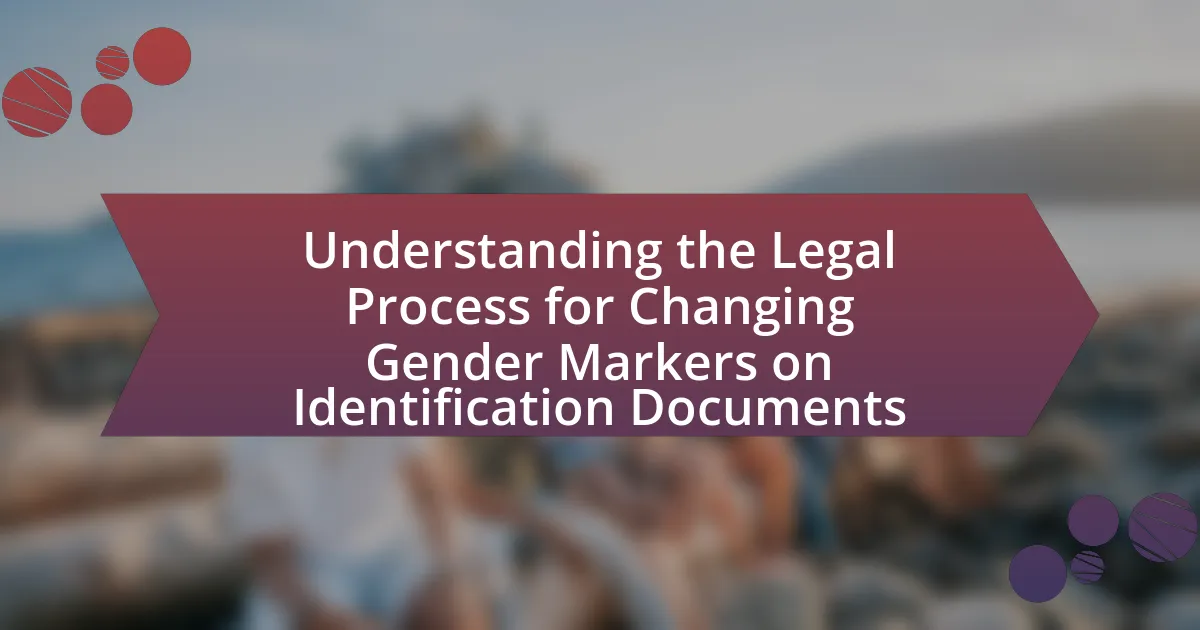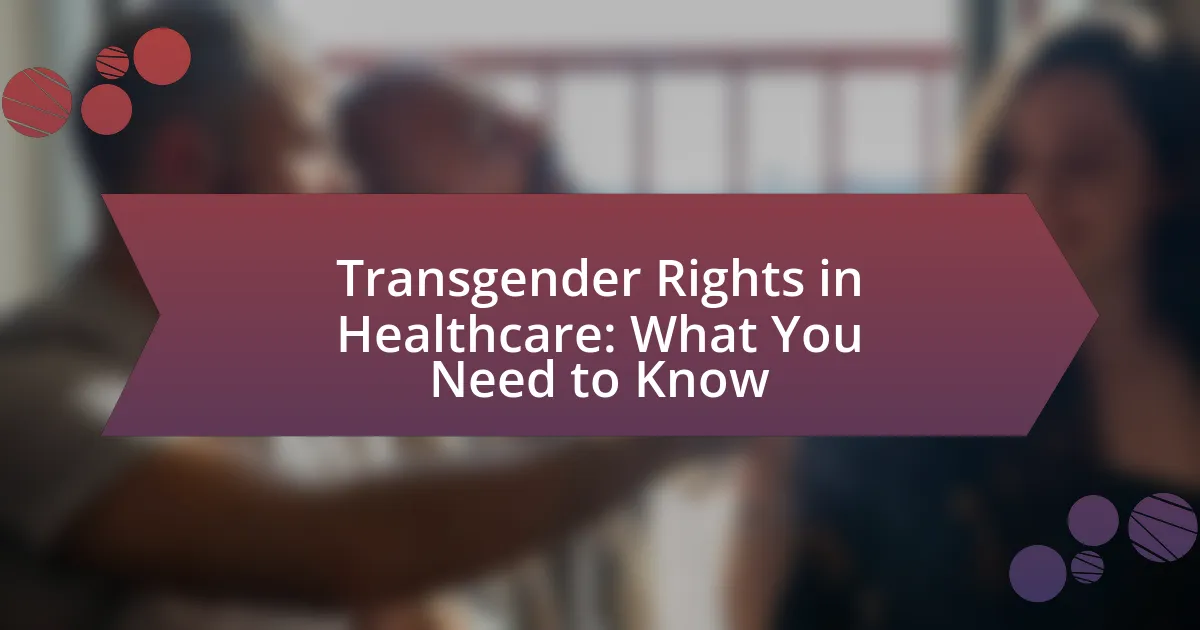The article focuses on the legal framework for LGBTQ+ hate crime legislation, detailing how laws vary by country and the specific protections they offer against crimes motivated by bias related to sexual orientation and gender identity. It outlines the definition of LGBTQ+ hate crimes, the unique characteristics that distinguish them from other crimes, and the importance of having distinct legal definitions. Key components of such legislation, including enhanced penalties and law enforcement training, are discussed, along with the historical developments and societal influences that have shaped these laws. The article also addresses challenges in implementation, current trends, and best practices for improving the effectiveness of LGBTQ+ hate crime legislation.

What is the Legal Framework for LGBTQ+ Hate Crime Legislation?
The legal framework for LGBTQ+ hate crime legislation varies by country but generally includes laws that specifically address crimes motivated by bias against sexual orientation or gender identity. In the United States, for example, the Matthew Shepard and James Byrd, Jr. Hate Crimes Prevention Act of 2009 expanded federal hate crime laws to include those motivated by sexual orientation and gender identity, allowing for federal prosecution of such crimes. Similarly, many countries in Europe have enacted hate crime laws that include protections for LGBTQ+ individuals, reflecting a growing recognition of the need to address violence and discrimination based on sexual orientation and gender identity. These legal frameworks are supported by international human rights treaties, such as the International Covenant on Civil and Political Rights, which obligate signatory states to protect individuals from discrimination and violence.
How is LGBTQ+ hate crime defined within legal contexts?
LGBTQ+ hate crime is defined within legal contexts as a criminal act motivated by bias against an individual’s sexual orientation, gender identity, or gender expression. This definition is often codified in hate crime legislation, which recognizes that such crimes are not only offenses against individuals but also attacks on the community as a whole. For instance, the FBI’s Hate Crime Statistics Act includes sexual orientation and gender identity as categories for reporting hate crimes, highlighting the prevalence and societal impact of these offenses. Additionally, many jurisdictions have specific laws that enhance penalties for crimes committed with bias against LGBTQ+ individuals, reinforcing the legal recognition of the harm caused by such motivations.
What specific characteristics distinguish LGBTQ+ hate crimes from other crimes?
LGBTQ+ hate crimes are distinguished from other crimes primarily by their motivation, which is rooted in bias against sexual orientation or gender identity. This bias often manifests in extreme violence, targeting individuals based on their perceived or actual LGBTQ+ status, leading to a higher degree of psychological harm and societal impact. According to the FBI’s Hate Crime Statistics report, in 2020, 20.5% of reported hate crimes were motivated by sexual orientation bias, highlighting the prevalence of such crimes compared to other motivations. Additionally, LGBTQ+ hate crimes often involve specific forms of violence, such as sexual assault or torture, that are less common in non-bias-motivated crimes, further emphasizing their unique characteristics.
Why is it important to have a distinct definition for LGBTQ+ hate crimes?
A distinct definition for LGBTQ+ hate crimes is crucial because it ensures that the unique motivations and impacts of these crimes are recognized and addressed within the legal system. This specificity allows law enforcement and judicial entities to identify, categorize, and respond to incidents of violence and discrimination against LGBTQ+ individuals more effectively. For instance, the FBI’s Hate Crime Statistics report indicates that in 2020, 20.5% of hate crimes were motivated by sexual orientation bias, highlighting the prevalence of such crimes. By having a clear definition, it facilitates targeted prevention strategies, appropriate resource allocation, and the development of policies that specifically protect LGBTQ+ communities, ultimately fostering a safer environment for all individuals.
What are the key components of LGBTQ+ hate crime legislation?
The key components of LGBTQ+ hate crime legislation include enhanced penalties for crimes motivated by bias against sexual orientation or gender identity, provisions for data collection on hate crimes, and measures to ensure law enforcement training on LGBTQ+ issues. Enhanced penalties serve to deter hate crimes by imposing stricter sentences, reflecting the severity of bias-motivated violence. Data collection is crucial for understanding the prevalence of such crimes and informing policy decisions; for example, the FBI’s Hate Crime Statistics Act mandates the reporting of hate crimes, including those targeting LGBTQ+ individuals. Additionally, law enforcement training ensures that officers are equipped to handle cases sensitively and effectively, fostering trust within LGBTQ+ communities.
What types of protections are typically included in these laws?
LGBTQ+ hate crime legislation typically includes protections against violence, harassment, and discrimination based on sexual orientation and gender identity. These laws often enhance penalties for crimes motivated by bias against LGBTQ+ individuals, ensuring that hate crimes are prosecuted more rigorously. For instance, the Matthew Shepard and James Byrd, Jr. Hate Crimes Prevention Act of 2009 expanded federal hate crime laws to include those motivated by sexual orientation and gender identity, providing a legal framework for increased protection and support for victims.
How do these laws vary across different jurisdictions?
Laws regarding LGBTQ+ hate crimes vary significantly across different jurisdictions, reflecting diverse legal frameworks and societal attitudes. For instance, some jurisdictions, like Canada, have comprehensive hate crime legislation that explicitly includes sexual orientation and gender identity as protected categories, while others, such as certain U.S. states, may lack specific protections or have varying degrees of enforcement. In the European Union, member states are required to implement laws against hate crimes, but the specifics can differ widely, with some countries offering robust protections and others having minimal legal recourse for victims. This variation is often influenced by historical, cultural, and political factors, leading to a patchwork of legal protections that can significantly impact the safety and rights of LGBTQ+ individuals in different regions.
Why is understanding this legal framework crucial for advocacy?
Understanding the legal framework for LGBTQ+ hate crime legislation is crucial for advocacy because it enables advocates to effectively navigate and utilize the laws that protect marginalized communities. This knowledge allows advocates to identify legal protections, challenge discriminatory practices, and promote policy changes that enhance safety and equality. For instance, the Matthew Shepard and James Byrd, Jr. Hate Crimes Prevention Act of 2009 expanded federal hate crime laws to include those motivated by sexual orientation and gender identity, illustrating the importance of legal frameworks in providing specific protections. By comprehending these laws, advocates can better support victims, influence legislation, and foster a more inclusive society.
How can knowledge of the legal framework empower LGBTQ+ communities?
Knowledge of the legal framework empowers LGBTQ+ communities by providing them with the tools to advocate for their rights and protections against discrimination and violence. Understanding laws such as the Equality Act in the United States, which prohibits discrimination based on sexual orientation and gender identity, enables individuals to recognize when their rights are being violated and to seek legal recourse. Additionally, awareness of hate crime legislation, which often includes enhanced penalties for crimes motivated by bias against LGBTQ+ individuals, equips communities to report incidents effectively and demand accountability. This legal knowledge fosters a sense of agency and encourages active participation in civic engagement, ultimately leading to stronger advocacy for policy changes that promote equality and safety.
What role do legal frameworks play in combating discrimination?
Legal frameworks play a crucial role in combating discrimination by establishing clear prohibitions against discriminatory practices and providing mechanisms for enforcement. These frameworks, such as anti-discrimination laws and hate crime legislation, create a legal basis for individuals to seek justice and hold perpetrators accountable. For instance, the Civil Rights Act of 1964 in the United States prohibits discrimination based on race, color, religion, sex, or national origin, thereby setting a precedent for legal recourse. Additionally, specific laws targeting hate crimes, such as the Matthew Shepard and James Byrd, Jr. Hate Crimes Prevention Act, enhance protections for marginalized groups, including the LGBTQ+ community, by recognizing bias-motivated violence as a distinct offense. This legal recognition not only deters discriminatory behavior but also promotes societal change by affirming the value of diversity and inclusion.

What are the historical developments in LGBTQ+ hate crime legislation?
Historical developments in LGBTQ+ hate crime legislation include the gradual recognition of hate crimes based on sexual orientation and gender identity, culminating in significant legal protections. In 1990, the United States enacted the Hate Crime Statistics Act, which mandated the collection of data on hate crimes, including those targeting LGBTQ+ individuals. This was followed by the 2009 Matthew Shepard and James Byrd, Jr. Hate Crimes Prevention Act, which expanded federal hate crime laws to include crimes motivated by sexual orientation and gender identity, as well as disability. Additionally, various states have implemented their own hate crime laws, with many explicitly including protections for LGBTQ+ individuals, reflecting a broader societal acknowledgment of the need for legal safeguards against such crimes. These legislative milestones demonstrate a significant shift towards recognizing and addressing violence against the LGBTQ+ community within the legal framework.
How have societal attitudes influenced the evolution of these laws?
Societal attitudes have significantly influenced the evolution of LGBTQ+ hate crime legislation by shifting public perception towards greater acceptance and recognition of LGBTQ+ rights. For instance, as societal attitudes became more supportive of LGBTQ+ individuals, evidenced by the increasing number of Pride events and public opinion polls showing majority support for LGBTQ+ rights, lawmakers responded by enacting more comprehensive hate crime laws. In the United States, the Matthew Shepard and James Byrd, Jr. Hate Crimes Prevention Act of 2009 was a direct response to heightened awareness and condemnation of violence against LGBTQ+ individuals, reflecting a societal demand for legal protections. This evolution illustrates how changing societal norms can lead to legislative advancements that protect marginalized communities.
What landmark cases have shaped LGBTQ+ hate crime legislation?
Landmark cases that have shaped LGBTQ+ hate crime legislation include the 1993 case of Matthew Shepard’s murder, which led to increased advocacy for hate crime laws, and the 2009 enactment of the Matthew Shepard and James Byrd, Jr. Hate Crimes Prevention Act, which expanded federal hate crime protections to include those targeted due to sexual orientation and gender identity. Additionally, the 2012 case of the U.S. v. Windsor, which struck down parts of the Defense of Marriage Act, influenced the legal landscape by affirming the rights of LGBTQ+ individuals, thereby impacting hate crime legislation indirectly. These cases collectively underscore the evolution of legal protections against hate crimes targeting the LGBTQ+ community.
How have advocacy efforts contributed to legal changes?
Advocacy efforts have significantly contributed to legal changes by mobilizing public support and influencing policymakers to enact legislation that protects marginalized communities. For instance, organizations like the Human Rights Campaign have played a pivotal role in lobbying for the inclusion of sexual orientation and gender identity in hate crime laws across various states. This advocacy has resulted in the passage of laws such as the Matthew Shepard and James Byrd, Jr. Hate Crimes Prevention Act in 2009, which expanded federal hate crime protections to include those targeted due to sexual orientation and gender identity. Such legislative changes demonstrate the direct impact of organized advocacy on shaping legal frameworks that address hate crimes against LGBTQ+ individuals.
What challenges have been faced in the implementation of these laws?
The implementation of LGBTQ+ hate crime legislation has faced several challenges, including inadequate training for law enforcement, lack of awareness among the public, and insufficient data collection. Law enforcement agencies often struggle to properly identify and categorize hate crimes due to a lack of specialized training, which can lead to underreporting and misclassification of incidents. Additionally, public awareness campaigns are often limited, resulting in a lack of understanding about what constitutes a hate crime, which further hinders reporting and enforcement. Furthermore, many jurisdictions do not have robust systems for collecting and analyzing data on hate crimes, making it difficult to assess the effectiveness of the laws and identify trends. These challenges collectively impede the successful implementation and enforcement of LGBTQ+ hate crime legislation.
What are common barriers to effective enforcement of LGBTQ+ hate crime laws?
Common barriers to effective enforcement of LGBTQ+ hate crime laws include underreporting of incidents, lack of training for law enforcement, and societal stigma. Underreporting occurs because victims may fear discrimination or not trust the police, leading to fewer recorded incidents. A study by the Bureau of Justice Statistics found that nearly 50% of hate crime victims do not report their experiences to law enforcement. Additionally, law enforcement agencies often lack specific training on LGBTQ+ issues, which can result in inadequate responses to hate crimes. For instance, a report from the National Center for Lesbian Rights highlighted that many officers are not familiar with the nuances of LGBTQ+ hate crimes, affecting their ability to investigate effectively. Societal stigma surrounding LGBTQ+ identities can further discourage victims from seeking justice, as they may worry about being judged or not believed. These factors collectively hinder the enforcement of laws designed to protect LGBTQ+ individuals from hate crimes.
How do biases within the legal system affect the prosecution of hate crimes?
Biases within the legal system significantly hinder the prosecution of hate crimes by influencing law enforcement practices, judicial decisions, and the overall treatment of victims. For instance, implicit biases among police officers can lead to underreporting or misclassification of hate crimes, as seen in studies indicating that law enforcement may not recognize certain acts as hate crimes due to stereotypes or preconceived notions about the victims. Furthermore, biases in the judicial system can result in leniency towards perpetrators, as evidenced by research showing that judges may impose lighter sentences for hate crimes when the victim belongs to marginalized groups. These systemic biases ultimately contribute to a lack of accountability and justice for victims of hate crimes, undermining the effectiveness of hate crime legislation designed to protect vulnerable communities.

What are the current trends and future directions in LGBTQ+ hate crime legislation?
Current trends in LGBTQ+ hate crime legislation include the expansion of legal protections and the increasing recognition of hate crimes based on sexual orientation and gender identity. Many jurisdictions are amending existing laws to explicitly include LGBTQ+ individuals, reflecting a growing awareness of the unique vulnerabilities faced by this community. For instance, the FBI’s Hate Crime Statistics report shows a rise in reported hate crimes against LGBTQ+ individuals, prompting lawmakers to enhance penalties and improve reporting mechanisms. Future directions indicate a potential for federal legislation that could standardize protections across states, as seen in proposals like the Equality Act, which aims to prohibit discrimination based on sexual orientation and gender identity in various areas, including hate crimes. This legislative momentum suggests a shift towards more comprehensive and inclusive legal frameworks to address and prevent violence against LGBTQ+ individuals.
How are recent developments in society impacting legislation?
Recent developments in society, particularly increased awareness and advocacy for LGBTQ+ rights, are significantly impacting legislation by prompting lawmakers to introduce and amend laws aimed at protecting marginalized communities. For instance, the rise in reported hate crimes against LGBTQ+ individuals has led to legislative efforts such as the introduction of the Equality Act in the United States, which seeks to expand civil rights protections. Additionally, public opinion has shifted favorably towards LGBTQ+ rights, as evidenced by a 2021 Gallup poll showing that 70% of Americans support same-sex marriage, influencing legislators to align laws with societal values. These societal changes are driving a legislative response that aims to enhance protections against hate crimes and discrimination based on sexual orientation and gender identity.
What role does technology play in the reporting and prosecution of hate crimes?
Technology plays a crucial role in the reporting and prosecution of hate crimes by facilitating the collection, analysis, and dissemination of evidence. Digital platforms enable victims to report incidents anonymously and access support services, which increases the likelihood of reporting such crimes. For instance, online reporting tools and mobile applications have been developed to streamline the process, making it easier for victims to document their experiences.
Moreover, technology aids law enforcement agencies in gathering and analyzing data related to hate crimes. Advanced analytics and machine learning algorithms can identify patterns and trends in hate crime incidents, allowing for more targeted interventions. According to a report by the FBI, the use of technology in crime analysis has led to improved response strategies and resource allocation in addressing hate crimes.
Additionally, social media platforms serve as both a source of evidence and a means for community awareness. Posts, comments, and messages can be used in court to substantiate claims of hate crimes, while campaigns on these platforms can raise awareness and encourage reporting. The integration of technology in these processes not only enhances the efficiency of investigations but also fosters a more informed public, ultimately contributing to the prosecution of hate crimes.
How are lawmakers addressing emerging issues related to LGBTQ+ hate crimes?
Lawmakers are addressing emerging issues related to LGBTQ+ hate crimes by introducing and amending legislation that enhances protections for LGBTQ+ individuals. For instance, the Matthew Shepard and James Byrd, Jr. Hate Crimes Prevention Act, enacted in 2009, expanded federal hate crime laws to include those motivated by sexual orientation and gender identity. Additionally, various states are enacting their own laws to strengthen penalties for hate crimes targeting LGBTQ+ individuals, reflecting a growing recognition of the need for specific legal protections. Recent reports indicate a rise in hate crimes against LGBTQ+ individuals, prompting lawmakers to prioritize these issues in legislative agendas, thereby ensuring that law enforcement agencies receive training on recognizing and addressing such crimes effectively.
What best practices can be adopted to strengthen LGBTQ+ hate crime legislation?
To strengthen LGBTQ+ hate crime legislation, jurisdictions should implement comprehensive data collection on hate crimes, including specific tracking of LGBTQ+ incidents. This practice allows for informed policy-making and resource allocation, as evidenced by the FBI’s Hate Crime Statistics report, which shows that jurisdictions with robust data collection mechanisms can better address and prevent hate crimes. Additionally, enhancing training for law enforcement on LGBTQ+ issues fosters a more informed response to hate crimes, as studies indicate that police sensitivity training improves reporting and victim cooperation. Finally, establishing clear legal definitions of hate crimes that explicitly include sexual orientation and gender identity ensures that legislation is inclusive and effective, as seen in states that have adopted such definitions, leading to increased prosecution rates.
How can community engagement improve the effectiveness of these laws?
Community engagement can significantly improve the effectiveness of LGBTQ+ hate crime legislation by fostering trust between law enforcement and marginalized communities. When community members actively participate in the development and implementation of these laws, they provide valuable insights into the specific challenges they face, which can lead to more tailored and effective legal responses. For instance, studies have shown that jurisdictions with strong community-police partnerships report higher rates of hate crime reporting and victim cooperation, which enhances the enforcement of laws. Additionally, community engagement initiatives, such as awareness campaigns and educational programs, can help to inform the public about the laws, thereby increasing their visibility and deterrent effect. This collaborative approach not only empowers communities but also ensures that the laws are more reflective of the needs and realities of those they aim to protect.
What strategies can be employed to raise awareness about LGBTQ+ hate crimes?
To raise awareness about LGBTQ+ hate crimes, targeted educational campaigns can be employed. These campaigns should focus on disseminating information about the prevalence and impact of such crimes, utilizing statistics from credible sources like the FBI’s Hate Crime Statistics report, which indicates that LGBTQ+ individuals are often disproportionately affected by hate crimes. Collaborating with LGBTQ+ organizations to host community workshops and seminars can further enhance understanding and foster dialogue. Additionally, leveraging social media platforms to share personal stories and testimonials can humanize the issue, making it more relatable and urgent. Engaging local law enforcement in training sessions about recognizing and responding to LGBTQ+ hate crimes can also improve reporting and support for victims.
